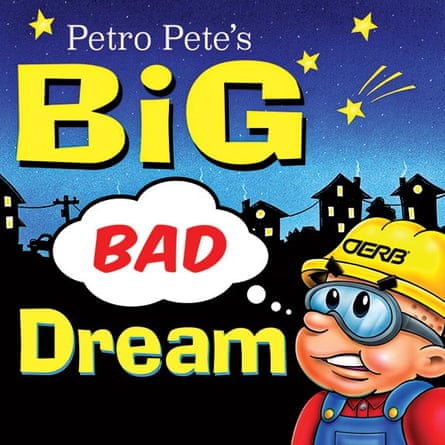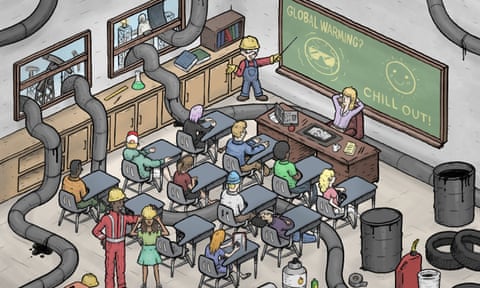This story was a collaboration between the Center for Public Integrity and StateImpact Oklahoma, a reporting project of NPR member stations in Oklahoma.
Jennifer Merritt’s first graders at Jefferson elementary school in Pryor, Oklahoma, were in for a treat. Sitting cross-legged on the floor, the students gathered for story time with two special guests, Republican lawmakers Tom Gann and Marty Quinn.
Dressed in suits, the two men read aloud from “Petro Pete’s Big Bad Dream,” a parable in which a Bob the Builder-lookalike awakens to find his toothbrush, hard hat and even the tires on his bike missing.
Abandoned by the school bus, Pete walks to Petroville elementary in his pajamas.
“It sounds like you’re missing all of your petroleum by-products today!” Pete’s teacher, Mrs Rigwell, exclaims, extolling oil’s benefits to Pete and fellow students like Sammy Shale. Before long, Pete decides that “having no petroleum is like a nightmare!”
The tale is the latest in an illustrated series by the Oklahoma Energy Resources Board, a state agency funded by oil and gas producers. The board has spent upwards of $40m over the past two decades on providing education with a pro-industry bent, including hundreds of pages of curriculums, a speaker series and an after-school program – all at no cost to educators of children from kindergarten to high school.

A similar program in Ohio shows teachers how to “frack” Twinkies using straws to pump for cream to emulate shale drilling. A national program sponsored by companies including BP and Shell claims it’s too soon to tell if the earth is heating up, but “a little warming might be a good thing”.
Decades of documents reviewed by the Center for Public Integrity reveal a tightly woven network of organizations that works in concert with the oil and gas industry to paint a rosy picture of fossil fuels in America’s classrooms. Led by advertising and public-relations strategists, the groups have long plied the tools of their trade on impressionable children and teachers desperate for resources.
Proponents of programs like the one in Oklahoma say they help the oil and gas industry replenish its aging workforce by stirring early interest in science, technology, engineering and math. But some experts question the educational value and ethics of lessons touting an industry that plays a central role in climate change and air pollution.
Anthony Leiserowitz, director of the Yale Program on Climate Change Communication, likened industry-sponsored curriculums that ignore climate science to advertising. “You’re exploiting that trusted relationship between the student and the teacher,” he said. Leiserowitz – whose research has focused on how culture, politics and psychology impact public perception of the environment – said fossil-fuel companies have a stake in perpetuating a message of oil dependency.
As early as the 1940s, the industry’s largest and most powerful lobby group targeted schoolchildren as a key element of its fledgling marketing strategy. By the 1960s, the American Petroleum Institute was looking to shake its reputation as a “monopoly which reaped excessive profits” and set out to cultivate a network of “thought leaders” that included educators, journalists, politicians and even clergy, according to an organizational history copyrighted by API in 1990.
The idea caught on. Hundreds of oil-and-gas-centric lesson plans are now available online, walking a blurry line between corporate sponsorship and promotion at a time when climate science has increasingly come under siege at the highest levels of government.
On 1 June, Donald Trump, flanked by EPA administrator – and former Oklahoma attorney general – Scott Pruitt, announced that the United States would withdraw from the Paris climate agreement.
Oklahoma is among a dozen states that have opted for watered-down versions of Next Generation Science Standards, a joint effort by states and educational organizations to revamp science teaching that has met with political backlash since 2013. The Oklahoma version strips provisions on evolution and the human causes of global warming. Along with Colorado, Kansas and Montana, Oklahoma legislators have also championed bills requiring educators teach “both sides” of those scientific concepts.
A 2016 study confirmed that America’s youth receive “mixed messages” on climate change. Nearly a third of middle-and-high-school science teachers nationwide have wrongly suggested global warming is naturally occurring. A quarter have spent as much time rebutting evidence of warming as they have presenting it.
Schools and libraries across Oklahoma have received more than 9,000 complimentary copies of Petro Pete’s Big Bad Dream since it was published last year. The story has been a hit with Jennifer Merritt’s students, who won the storytelling visit from lawmakers last November after submitting a Facebook photo to the energy resources board. Posing on a jungle gym, the students clutched stuffed animals and footballs – their “favorite petroleum by-products”.
“It’s not some boring thing,” Merritt said of the board’s “Little Bits” curriculum for children up to age eight, which features alliterative characters like Freddie Fuelless and Oliver Oilpatch. Without it, she said, “I probably wouldn’t have taught first graders about energy.”
Merritt is one of 14,000 Oklahoma teachers who have attended workshops on how to use the board’s “innovative, one-of-a-kind science and energy curriculum in their classrooms.” Participants are reimbursed for supplies year-round and can register their classes for free museum field trips – so long as the exhibits highlight petroleum.
On a recent Saturday, a workshop was in session at Choctaw high school, east of Oklahoma City. The parking lot was bustling as teachers loaded their cars with heavy tubs, each stuffed with up to $1,200 worth of calculators, lab equipment and other materials. In classrooms, some teachers plotted oil-production trends while others watched bubbling brews simulating how the industry wrings oil from depleting fields.
In an email, board chairman Danny Morgan wrote that the organization doesn’t use public funds and “does not function like a typical agency”. Under state law, half of its revenues from oil and gas producers are spent restoring abandoned oil wells. Morgan pointed to a board safety campaign aimed at preventing children from playing on dangerous pumpjacks that dot the state, writing, “if just one child is kept safe through the awareness this program created, it is well worth the effort.”
While the board’s curriculum enlightens students about the benefits of “black gold,” their teachers are hard-pressed to find any information on climate change or other drawbacks of fossil fuels – even as Oklahoma struggles to curb a slew of man-made earthquakes tied to its fracking boom. Morgan, an oil company executive and a former state legislator, declined to say why the board’s materials fail to address global warming.
Cheerleading for the industry has been central to the energy resources board’s mission from the start. Lawmakers created the board in 1993 as a “privatized” state agency funded by a voluntary tax on local oil and gas producers to publicize the industry. Kansas, Illinois and Ohio followed suit with similar legislation.
But Oklahoma remains the epicenter of oil-industry puffery in the classroom. The board’s curriculums are used in an estimated 98% of Oklahoma school districts and have been adopted in neighboring Kansas. Records show that the board’s programs and pro-industry ads have been held out as models to trade groups and legislators in Montana, Arkansas, North Dakota, Wyoming and Texas.

Oklahoma’s board appears to have taken cues from the American Petroleum Institute – the country’s leading oil and gas lobby group, representing more than 625 companies. The plot of Big Bad Dream bears uncanny similarities to API’s 1996 educational film, “Fuel-less: you can’t be cool without fuel”. Records show that the board’s education director, who wrote Big Bad Dream, has ordered hundreds of copies of “Fuel-less” to distribute locally – most recently in 2013. API did not respond to requests for comment.
API’s vice-president of communications delivered a special presentation to the board in 2012 on marketing strategies. The same year, an API lobbyist asked the board to host a fracking workshop on its behalf as part of the trade group’s effort to reach out to legislators, regulators and other stakeholders nationwide. Morgan wrote that the board did not participate in the workshop because API “never followed up on the request.” He added that the board itself doesn’t engage in lobbying.
Copied on API’s communications with the energy resources board was Bill Whitsitt, a Devon Energy executive who helped draft Pruitt’s letters during his tenure as Oklahoma attorney general. In 2014, the New York Times reported on Pruitt’s extensive industry ties — which included oil and gas companies, utilities and lobby groups.
As the state’s legal chief, Pruitt vociferously litigated against environmental regulations like the Clean Power Plan, branding them job killers and federal overreach. Devon Energy has been cited as an early beneficiary of rollbacks under Pruitt’s watch since he took the helm of the EPA in late January.
Carla Schaeperkoetter, the energy resources board’s education director, is the creator of “Big Bad Dream” and “Lab Time with Leo” – a video series featuring a bowtie-wearing scientist not unlike Bill Nye the Science Guy. Instead of exploring fundamentals like the solar system, Leo delves into the nuances of oil refining, teaching kids as young as eight about “fractional distillation” and “residuals.”
Schaeperkoetter doesn’t have any teaching experience and isn’t a state employee. Board staff, including Schaeperkoetter, are consultants hired by a private foundation affiliated with the Oklahoma Independent Petroleum Association. The state trade group is listed as a partner of the Independent Petroleum Association of America, a lobbying organization that worked closely with API to roll back federal rules on fracking.
Schaeperkoetter’s name appears on curriculums reassuring teachers that “companies are spending more dollars protecting the environment than drilling new wells.” A jump-rope rhyme reads, “We need oil. We need gas. Where are the oil products in our class?” And a high school guide asks students to create 30-second commercials on how “oil and natural gas will help America be energy independent”.
Charles Anderson – a professor at Michigan State University who studies environmental literacy and develops curriculums – said the board materials are upfront about their pro-industry agenda but only tell “half the story” by omitting global issues like climate change in favor of niche oil knowledge. “The children of Oklahoma are getting a raw deal – they are getting educationally ineffective materials teaching content that will be of little use to them if they want to leave the state,” Anderson said.
Students also are being sold short in more immediate ways: an increasing number of Oklahoma districts are adopting four-day school weeks amid budget cuts due partly to tax breaks for the petroleum industry. “The state government of Oklahoma, in its wisdom, has decided that oil and gas companies should have a whole lot of money and schools should have hardly any money,” Anderson said. “That’s a social decision that values oil and gas extraction over the public good of public schools.”
Oklahoma’s state department of education promotes energy board lessons online and in newsletters. Though the curriculums are described by the board as having been developed in “a collaborative effort” with the state, the education department has “not reviewed, endorsed or had any oversight” over the materials in two decades, spokeswoman Anne Price said.

“We value curricula that align to our state standards and are at no cost to educators, but ultimately we encourage educators to investigate further to choose what is best for their classrooms,” Price wrote in an email.
Without explicit guidance, experts say, it’s difficult for educators to assess which materials are appropriate – especially elementary-school teachers who don’t have extensive science training. Historically, energy curriculums have been scarce.
“This provides an opportunity for anyone who has a particular point of view, whether it’s an oil company or an environmental concern,” said David Evans, executive director of the National Science Teachers Association, which co-developed the Next Generation Science Standards.
The standards specify which concepts students should grasp by grade level – like the greenhouse effects of gases like carbon dioxide and methane – but don’t provide curriculums, leaving educators to find or create lessons themselves. So far, the standards have been adopted by 18 states and the District of Columbia.
When it comes to climate change, Evans urges teachers to stick to facts and avoid politics. “Science is about understanding the physical world that we live in,” he said. “We wouldn’t say, ‘Why should people understand gravity?’”
But education is inherently political, said Nicole Colston, a researcher at Oklahoma State University who has studied overlap between groups that push against evolution and climate change education. “It’s this implied thing that you can’t talk about climate change,” she said of her interviews with Oklahoma teachers. “It’s almost, like, impolite or uncomfortable.”
Prominent Oklahomans like Pruitt and Republican US senator James Inhofe are climate-science deniers, a fact not lost on the state’s residents. Just 46% of adult Oklahomans believe global warming is caused by human activities, below the national average of 53%, according to 2016 data from the Yale Program on Climate Change Communication.
In 2014, Oklahoma lawmakers tried but failed to block the state board of education from adopting its version of Next Generation Science Standards. The same year, a state law was passed to give local school districts ultimate authority over curriculums.
Merritt said she chose to use energy resources board materials because they were age-appropriate, factual, and free. “It’s just a way of life,” she said of the curriculum’s laser focus on petroleum. “We live in Oklahoma. There’s a lot of oil.”
Joe Wertz, a reporter with StateImpact Oklahoma, contributed to this story









